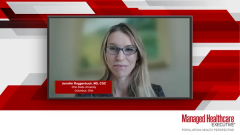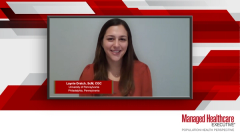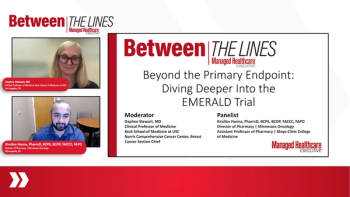
Exploring the Patient Journey of ALS
Jennifer Roggenbuck, MS, LGC, opens a discussion on patient journeys with ALS.
Episodes in this series

Jennifer Roggenbuck, MS, LGC: A patient’s journey to get a diagnosis of ALS [amyotrophic lateral sclerosis] usually begins with symptoms of muscle weakness in 1 body part, most often an arm or a leg. We call that limb-onset ALS. There’s also the possibility that it could start in the mouth, so speaking or swallowing problems can also be the first ALS symptom. Whether it’s limb onset or bulbar onset, which is onset with speaking or swallowing, ALS usually isn’t the first thing to cross off the list in terms of a possible cause for muscle weakness. The individual may see a primary care doctor, a nurse practitioner, or a physical therapist and not identify a cause immediately. ALS is progressive, so as the weakness progresses, they may also get referred to a spinal surgeon, or various other potential causes might be considered and worked up. This can take years. It can vary quite a bit from patient to patient about how long it takes, how quickly they seek medical attention, and the expertise of the team that’s seeing them.
The patient journey usually includes a special study called an EMG [electromyography]. This is a test where we check the electrical activity of the motor neurons and the muscles. This is often key to an ALS diagnosis because it can identify that lower motor neuron involvement that’s a part of ALS. The patient journey is months or even years before we get an answer about the cause of the symptoms. The first symptom, muscle weakness of 1 body part, seems benign. Individuals might just be tripping or having some weakness in their foot. Years later that can lead to getting a diagnosis of ALS. It depends on a lot of factors that are often beyond the patient’s control. That’s a frustrating process for individuals with ALS—the long diagnostic journey and having a lot of things considered and ruled out before getting that answer.
The most common age of onset is in the 60s for someone with ALS, and there’s some variability in terms of the age of onset in different populations around the world. The average age of onset is in the 60s. For patients who have a family history of ALS, the age of onset is in the 50s.
Patients with ALS may or may not have other comorbidities. In fact, many patients with ALS are healthy and have a benign medical history. We don’t see any comorbidities that clue us in to them having ALS. There’s some evidence that individuals who are thin and athletic may have a slightly higher chance of getting ALS. We see ALS occurring alongside many disorders, but we don’t see a pattern. ALS can happen to any individual, and that individual may or may not have other health concerns at the same time.
The lifespan for a patient with ALS after their diagnosis ranges from 2 to 5 years on average. There are a lot of variabilities, so it’s difficult to predict a patient’s expected survival at the time of their diagnosis. There are some genetic forms of ALS where symptoms progress more quickly and death occurs within months to a year after diagnosis. That’s rare. On the other hand, some patients with ALS who have slowly progressive symptoms can live for 10 years or more. But on average, it’s 2 to 5 years of survival after their diagnosis.
One way to shorten the time it takes to diagnose patients is to educate medical practitioners about ALS and to have ALS on that differential diagnosis for patients who present with weakness. Of course, there are many possible causes of weakness and they could be for things that are much more common than ALS. One thing that’s potentially helpful is for family physicians and interns to be aware of the patient’s family history. If there’s a family history of ALS, then having that awareness can keep ALS on the list of possibilities for consideration if a patient were to present with limb weakness or bulbar weakness. It’s a matter of awareness and education for health care providers to keep ALS in mind as a possibility when someone presents with local weakness.
Laynie Dratch, ScM, CGC: The ALS journey is very different for each individual, and it can depend on how the symptoms start, which can vary from patient to patient. Sometimes individuals will experience changes in their limbs and feel things like weakness. Often, I have patients come in and say their golf game has changed. They’ve noticed they feel weak, or that it’s harder for them when they’re getting out of chairs or going on walks, or they tire more easily. Sometimes patients with ALS have symptoms start in the bulbar region, and it can look like changes in speech or swallowing. This can be devastating for individuals as others recognize their speech sounds slurred, or if they start to choke when they’re eating. It can look very different for different patients, and the progression can also look different in each patient in terms of the duration and which symptoms present.
Even though we think about ALS in terms of weakness, cramping, and fasciculations, a substantial number of individuals develop cognitive concerns as well, whether that’s mild cognitive impairment or symptoms of the related condition called frontotemporal degeneration, which can present with changes in behavior, personality, or even language. ALS typically starts in an individual’s 40s through 70s, but there’s extreme variability; it can start younger or older. The most common age of onset seems to be in the 50s. It’s a little more common of a diagnosis in men than women. When there’s a genetic form of disease, it tends to start a little earlier, but that’s not always the case. There’s extreme variability.
One of the most common comorbidities that we see in our clinic is frontotemporal degeneration, or FTD. This is a disorder that can cause drastic changes in behavior and personality rather than what you might think of when you hear the word dementia; sometimes individuals call this frontotemporal dementia. It doesn’t look like Alzheimer disease where patients are having problems with their memory.
Individuals can have many changes in their behaviors. They can go from being really shy to really outgoing or vice versa. They can have weird interactions with strangers that are out of character, such as showing up at a neighbor’s house uninvited or doing things in public that might be embarrassing or socially unacceptable—like taking off their clothes, hitchhiking when they don’t need to, shoplifting when they don’t need to—because they might have trouble controlling their impulses. This can get them into legal and financial trouble if they end up doing something like gambling, falling for scams, or giving away money. It can have a horrible impact for that individual and the family.
Because this disease also presents earlier compared with Alzheimer disease, sometimes it’s hard to recognize what it is. FTD is a diagnosis that can be challenging to get to. Sometimes individuals get psychiatric diagnoses first, but when it also presents with weakness, cramping, fasciculations, or changes in speech and swallowing, patients will sometimes end up with a diagnosis of both ALS and FTD. That’s 1 of the diseases that we see as a comorbidity.
Transcript edited for clarity.
Newsletter
Get the latest industry news, event updates, and more from Managed healthcare Executive.





















































